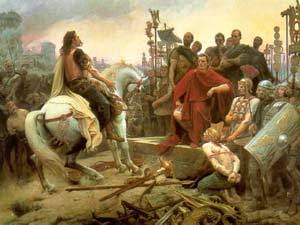|
The man who opposed an Empire
"Himself a man of boundless energy, he terrorized waverers with the rigours of an iron discipline."
Caesar
In 53 BC, when Caesar had left for Italy after the summer campaign season, the Gallic tribes rebelled under the leadership of Vercingetorix, who raised an army against the Roman legions still wintering in Gaul. Hearing of the rebellion, Caesar crossed the mountains in the south, digging through snow drifts six feet deep, to rejoin his troops. "The very vigour and speed of his march in such wintry conditions," says Plutarch, "was a sufficient advertisement to the natives that an unconquered and unconquerable army was bearing down upon them." To deprive the Romans of food and supplies, Vercingetorix had ordered a scorched-earth policy, and all the neighboring villages and farms were burned, "until fires were visible in all directions." But one tribe, already having torched twenty towns in a single day, refused to destroy its capital at Avaricum (Bourges), "almost the finest in Gaul, the chief defence and pride of their state." Vergingetorix relented and set about to help defend the fortified town, which held a large supply of grain so desperately needed by the Romans.
 Caesar began a siege that lasted twenty-seven days. It now was early spring 52 BC, and, in spite of incessant rain, two wheeled towers, eighty feet high, and ramps three hundred and thirty feet long, over which they could be rolled into place, as well as a high siege terrace, were constructed in less than a month. The Gauls did all they could to counter or destroy the siegeworks. As the towers increased in height, so the defenders raised their own. They attacked the soldiers at work and tunneled under the terrace to undermine it.
Caesar began a siege that lasted twenty-seven days. It now was early spring 52 BC, and, in spite of incessant rain, two wheeled towers, eighty feet high, and ramps three hundred and thirty feet long, over which they could be rolled into place, as well as a high siege terrace, were constructed in less than a month. The Gauls did all they could to counter or destroy the siegeworks. As the towers increased in height, so the defenders raised their own. They attacked the soldiers at work and tunneled under the terrace to undermine it.
As the terrace approached the height of the wall, the defenders became desperate. Caesar writes that "They felt that the fate of Gaul depended entirely on what happened at that moment, and performed before our eyes an exploit so memorable that I felt I must not leave it unrecorded." It was almost midnight when they again had dug under the terrace and set it on fire. Opposite one of the towers, a Gaul was throwing pitch and tallow onto the fire when he was killed by an arrow from a catapult. Another man stepped forward to take his place and he, too, was killed. Another came forward and also was killed. This continued throughout the night until the fire finally was extinguished.
The next day, it began to rain heavily and, as the defenders took shelter, one of the siege towers was moved into position. The Gauls, taken by surprise, were dislodged from the walls and, panicked at the sight of the Romans surrounding them, threw down their weapons and fled. Exasperated at the length and difficulty of the siege, the Romans massacred the inhabitants. No-one was spared, "neither old men nor women nor children. Of the whole population--about forty thousand--a bare eight hundred who rushed out of the the town at the first alarm got safely through to Vercingetorix."
As Caesar has Vercingetroix say, "The Romans have not won by superior courage or in fair fight...but by their expect knowledge of siegecraft, a special technique that we were unacquainted with."

|